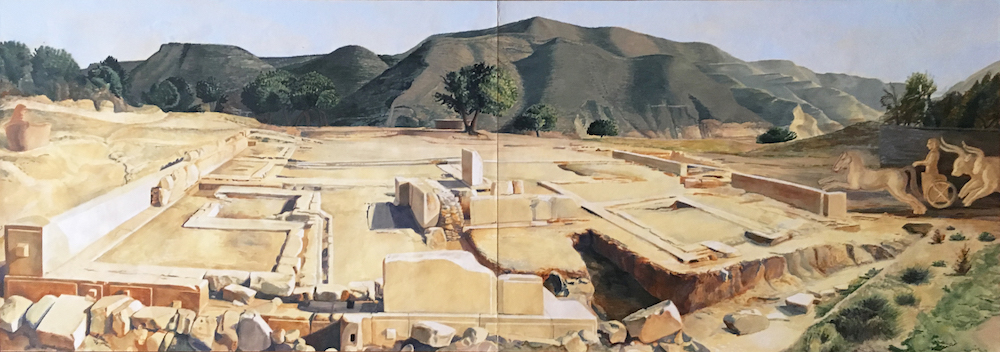Paintings and Drawings by Glynnis Fawkes
Show Dates: November 15, 2017 – February 16, 2018
Closing Celebration
Friday, February 16, 6:00-9:00 pm
The event included a talk by the artist and a performance of new ancient music for Euripides’ Helen by John Franklin and the Green Mountain Halcyonids.
Overview
From November 15, 2017 to February 16, 2018, the Center for Hellenic Studies showcased a series of paintings and drawings by artist Glynnis Fawkes that represent nearly 20 years of work relating to the landscapes of the Eastern Mediterranean. The exhibited pieces draw inspiration from both the archaeology and mythology of Greece and Cyprus.

About the Artist
Glynnis Fawkes is a cartoonist and archaeological illustrator living in Burlington, VT. She was a Fulbright Scholar in Cyprus and a resident at La Maison des Auteurs in Angoulême, France. Her graphic books won the Society of Illustrators MoCCA Art Festival Award two years in a row and her cartoons have recently been published on the website of The New Yorker.
About the Exhibition
While in Cyprus, Fawkes produced a book of paintings of archaeological sites, Archaeology Lives in Cyprus. The painting of Alassa from that series is also reproduced on the cover of John Franklin’s book, Kinyras the Divine Lyre (for which Fawkes also drew more than 50 illustrations). Some of the drawings from Cyprus she made directly from the landscape, some in the studio, where she played with reintroducing ancient artifacts into contemporary landscapes.
Her illustrations of the Homeric Hymn to Dionysos began as an experiment with pairing the format of comics with the text of the ancient hymn. Fawkes envisioned the action of the story taking place in the remembered landscapes of Greece, relying on ancient iconography for the ship, dolphins, and the character of youthful Dionysos. Fawkes painted these pages in acrylic, using Paynes Gray and Red Oxide. The red is reserved for the pirates and their ship, the blue for land and sea, and the colors are combined in the figure of the god, inspired by the description of Dionysos’ blue hair and purple cloak in the first few lines of the hymn.
Her illustrations for Greg Nagy’s translation of the newly discovered “Brother’s song” by Sappho imagine the characters overlooking the rocky cliffs and coasts of Lesbos as they express the same longing for the safety of relatives and themselves that is familiar to us now – especially felt, she imagines, by recent refugees who land on that shore. She drew from Google Image photos of Aegean storms and of refugees off the coast of Lesbos.
The accordion-fold book The Pleiads grew out of a Book Art show that took place in Nicosia, Cyprus in conjunction with a dance performance. This book is an interpretation of Alcman’s Partheneion. For the inspiration, the artist credits Gloria Ferarri’s Alcman and the Cosmos of Sparta, as well as the Ballet Russe’s L’Après-Midi d’un faune.
Several of the most recent drawings are pages from a book-in-progress, Alle Ego, a graphic memoir of her first trip to Greece as a graduate student and how she became enamored with its landscape and archaeology.
